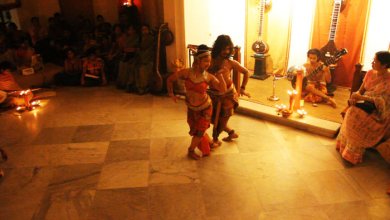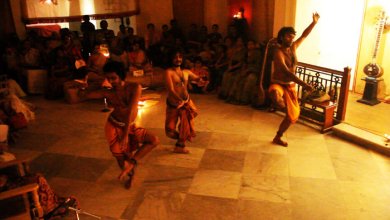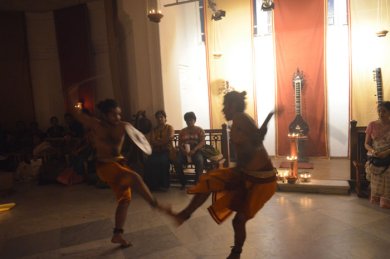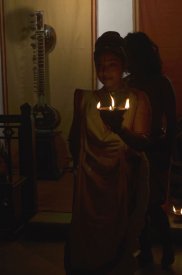
|   |

|   |
Kapaalgeeti-Vyahriti by Piyal Bhattacharya - Nita Vidyarthi e-mail: nitavidyarthi@gmail.com Photos courtesy: Piyal Bhattacharya July 28, 2014 Piyal Bhattacharya commonly known as Kalamandalam Piyal has been striving for years in research on the reconstruction of dance prescribed and elucidated in Bharatamuni’s Natya Shastra. His labour of 15 years has moved beyond the traditional Marga Natya repertoire, emerging as Marga Nritta, a way of presenting Bharatamuni’s dance and music form. His first production Kapaalgeeti - Vyahriti supported by The Harrington Street Arts Centre and Ministry of Culture, Government of India, gave an idea to the hitherto unknown aspects of the dance-music concept embedded in the text as interpreted by Piyal extending and improvising yet remaining in its domain while giving it a contemporary colour. Kapaalgeeti is recognized as the Brahma Geeti in Natya Shastra and are the manifestation of Shaiva tatva expressed through renditions of songs. Hence the concept of the production is deeply embedded in the core of ancient Shaiva philosophy and their vision of the efflorescence of the universe. Out of seven songs only three were chosen. They were Shadji, Madhyama and Gandhari Kapaalgeeti composed as Shuddha Shadji, Madhyama and Gandhari jaati. If sung properly, Kapaalgeeti transcends our mundane existence and paves the way to reach the ultimate consciousness. Vyahriti is the source of efflorescence of these geets. The ultimate truth can be realized in this case through singing and dancing. 

The huge marble floored room of the old colonial mansion with a high ceiling was a perfect setting for the recent production. The rectangular hall with the performance space of a smaller inner rectangle was lined with the select audience. Earthenware oil lamps in plenty in all sizes and shapes were the only source of illumination offering a peculiar mysticism with the refrain of the music. The orchestra or Kutap was settled in different positions on the sides of a square around the performance space. The performance began with Piyal playing a short piece on the Dardur (a percussion instrument similar to ghatam with the mouth covered with skin producing a bass note) and a light refrain from the flute. Right opposite across the performance space sat Abhijit Roy playing the sarod look-alike (sound similar too) Kachchapi Veena. The other ends were occupied by Sayak Mitra who was the gayak, the Kachchwa sitar (a smaller version of the regular instrument) and surbahar player. The flute or Sushir vadya was played by Nilanjan Das. Dipan Maitra, the Taaldharika, sat beside Roy. After ushering in the presentation with Dardur, Piyal shifted to playing the Rudra veena. The main taal accompaniment was the mridanga played by Mithun Chakravarty. The presentation begins with an idea of making the universe visible without light - “no drishti, no drashta” and an articulated sword fight by 4 female dancers with the Dakshina Kalika mantra signifying the emergence of Chhanda or Chandika Shakti depicting how the cosmic energy expands and starts creating Chhanda, as Chhanda is the pattern of emergence of this whole universe and prana. A short dhoti-clad, bare-bodied strong male dancer with long unkempt hair - the Nartak (Akaash Mullick) appears at this point and starts dancing in slow pace with the alaap of the various instruments by the Kutap or orchestra, gradually increasing the pace in multiples of four with the accompaniment of the music. This is improvisational alaap of the Shadji jaati to bring out and initiate the unmanifested and non attributed Bhairava roopa (the first image) of Shiva through nritta. The short but energetic closed steps of the dancer increased to long stretches, the microcosmic dance tending towards macrocosmic! The musical pattern signifies the process aftermath of Shakti’s expansion. The piece of rhythmic musical harmony created by the musicians was in accordance to the concept and format adopted from Asravan and Parigghattana of Natya Shastra according to Piyal. The dance in the production was composed of various karanas and angaharas appropriate to express the bhava. It is important to note that in almost all cases facial expressions were absent and it was the swaying or andolans of the body following the meedhs and gamaka of the alaap that spoke volumes of the vilaas or exaggerated softness and abstraction of the movements. Pataka hasta mudra was used liberally. The movements are claimed to have been influenced by the karana sculptures of Shiva in Chidambaram. This alaap and dancing according to Piyal was the suggestive of Vaak and the later part, the Shadji Kapaalgeeti and its magadhi style of rendition and dancing, was representative of Artha emanating from the Vaak. So, this section covers a journey from Vaak to Artha, from the unmanifested to the manifested form and its variants. Kaal in dance is taal divided into past, present and future and Prana is swar. The narrator or Chit-shakti appears at this point sitting at the centre of a triangle formed by a female and two male inquisitors. With the questions asked by the purusha, Shakti explains that she is the reason behind every manifestation of creation, the reason behind both cosmic and mundane dance as well. After this the purushas dance with Madhyama Kapaalgeeti while rendering the song themselves. The whole performance takes place in dimmed light.  While discussing with Piyal, he answered that, “this section was conceived because of various reasons. According to the vision of ancient Indian philosophy (mainly Shaiva and Agama), our universe emerges out of one cosmic formation of upward triangle. This holds the core of our genesis, but without the chit or consciousness there could never be any such emanation. So, in our production the Chit-shakti appears as the centre of every possible manifestation, be it cosmic or mundane. That is why she is the only one who can make us aware of our real ‘self’. We, the conditioned ‘self’ or purusha, has been represented conceptually in the figure of three inquisitors. As she stated that the purpose of any form of dance or music is to connect oneself with the ultimate form of truth or ‘being,’ this section was envisioned to establish and build a bridge between the journeys of our production from the unmanifested to manifested and back. So, this upward triangle formation and the appearance of Chit-shakti at the centre of it (representing the presence of chit or consciousness as the centre of the exposition of our universe), was indeed conceived with high importance, in order to practically conceptualize the core concepts behind our production.”  Again the Chit appears and elucidates the secret of cosmic contentment. As the supreme cosmic energy finishes its expansion in space, creating life through pulsation, the Shakti starts to mingle with the purusha with subtle amorousness filled with contentment as expressed in the sensuous duet by Akaash Mallick and Pinky Mondal. This was the efflorescence of love which gets reflected in each and every nucleus of the universe. “This Shakti is Hladini Shakti, the prime source of inspiration and satisfaction behind everything. As she appears, the contended universe moves towards saturation,” according to director Piyal. Needless to say, their bodies swaying under close grip became at times a wee bit uncomfortable to watch from the close proximity of the performance space. The concept of Hladini Shakti was conceptualized through the dance with Gandhari Kapaalgeeti. An improvised duet by Akaash and Pinky accompanies the song and the other dancers join in. This suggests the journey of gross and formed dance getting connected with the ultimate subtle dance and thus gradually moves towards formlessness. Tagore’s song from the puja section Charana dhoritey diyo go aamarey niyona niyona soraye (Let me touch your feet, please do not move them away), a song of appeal/prayer to the Almighty at the end came as a big surprise. It left many confused as to how the spiritual and devotional fervour of the song connected with the concept of the production. The ambitious project boasts of beautiful costumes of saris and dhotis dyed in earthy colours of muted brown, ecru and off white with stunning chunky, elaborate very pretty silver/white metal jewellery. The female dancers looked gorgeous and all were designed by Piyal who is also a fashion designer! He has put in a lot of hard work in this production but an important point remained unattended. He must put some thought for educating and preparing his audience, both lay and those with trained eyes as the dance form which he has evolved remains perplexing at some point even after being visually pleasing. The music could be explained also. Some lecture demonstrations or a seminar would help for people to understand his rigorous effort and insightful work. The hand note is not enough. The performance space was well decorated and had the right ambience but there was sound interference as a result of which the acoustics suffered. This might have been the reason that the last words of the sentences in Adrija Banerjee’s narration was inaudible in most cases. Instead of placing the stringed instrument players at 90 degrees to each other, it would have created better sound effect if they sat opposite to each other. Nita Vidyarthi is a critic of performing arts, specialising in dance, dance theatre and expressions and is a regular contributor to The Hindu, and the Statesman Kolkata in dance, vocal music and theatre. She is trained in Kathak, Bharatanatyam and Manipuri as well as vocal, semi-classical music and Rabindra Sangeet. A Science communicator, Ph.D. in Polymer Science, Commonwealth Scholar and a retired Professor of Chemistry, Nita devotes most of her time to dance and theatre writing. |